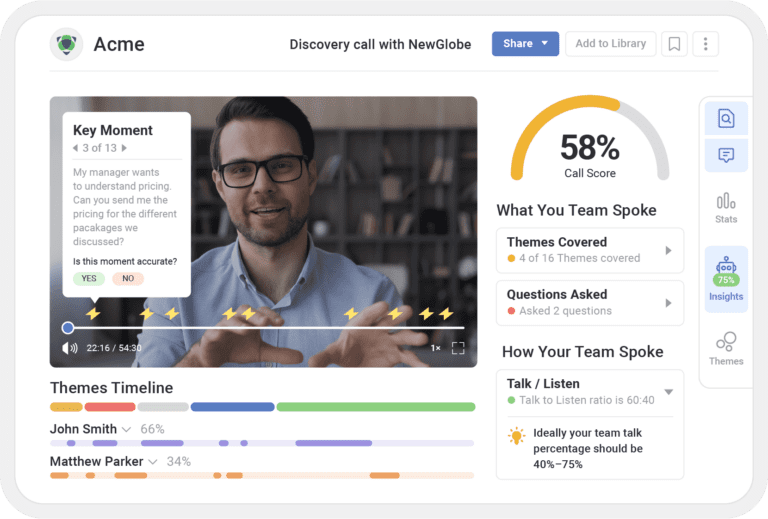Building relationships is essential in sales. Once you’ve established rapport and earned a prospect’s trust, they’re more likely to make a purchase and stay long-term.
Modern sales reps leverage many different techniques to build rapport. Sales mirroring is one that’s especially common and effective. In fact, research shows that sales mirroring can increase sales reps’ closing rates by 17%.
Sales mirroring can increase closing rates by
But what it? And what techniques can help you close more deals?
In this blog, we’ll discuss what mirroring in sales is and why it’s a powerful approach for closing more deals. We’ll also explore some techniques to consider – and some common pitfalls to avoid.
What is sales mirroring?
Sales mirroring (also known as sales mimicking) is a strategy sales reps use to build rapport and earn their prospects’ trust. But how exactly does it work?
Sales mirroring is based on psychology. Essentially, it involves a seller observing a prospect’s verbal and non-verbal cues – and then “mirroring” that communication style. The prospect feels heard and understood, which increases their likelihood of purchasing from the seller.
Sales reps can use mirroring when interacting with prospects at every stage of the sales cycle—from initial outreach to discovery to demo to negotiation to close—and everything in between. Sales mirroring (when it’s done well) can significantly impact a rep’s ability to move deals through the sales pipeline and ultimately close more of those deals.
Of course, mirroring can be used during verbal communication – such as sales calls and video conferencing. However, this technique can also be used in email and other written communication.
What are the benefits of sales mirroring?
In today’s world, 78% of B2B buyers expect companies to understand and adapt to their changing needs and preferences. Rattling off a generic list of product features and benefits won’t cut it.
Many sales reps practice sales mirroring to build customer relationships and earn trust. But why is this approach so popular?
Let’s examine some key reasons why sales mirroring is an important (and popular) tool for sales reps.
Sales mirroring helps sales reps build trust with prospects
When a seller earns a buyer’s trust, they’re more likely to win their business. Research from Forrester found that 83% of B2B buyers would recommend a trusted vendor to others outside the company.
The bottom line is that earning a prospect’s trust is foundational to winning and retaining customers.
Mirroring is a powerful way to build trust with prospects. When sales reps use sales mirroring, the buyer feels heard and respected, which increases trust and the prospect’s likelihood of making a purchase.
Sales mirroring builds relationships
Any successful sales rep knows that relationship-building is key. Strong relationships lead to more deals, renewals, and referrals.
Practicing mirroring is an effective way to grow relationships with customers. For starters, sales mirroring helps sales reps demonstrate commitment to understanding a customer’s challenges. When a buyer feels understood, they’re more likely to listen to a seller’s recommendations.
In addition, mirroring can help a prospect and sales rep identify things they have in common. These commonalities can help build strong, long-term relationships.
Sales mirroring helps sales reps understand a customer’s needs
Before recommending a solution, a seller must understand a buyer’s needs. Sales reps who practice mirroring observe a buyer’s verbal and nonverbal cues. By listening to what the prospect is saying—and how they’re saying it—the sales rep can truly understand the prospect’s unique needs. Then, they can develop a solution to address those needs.
Sales mirroring helps reps close more deals faster
Putting a lot of pressure on a buyer can seem like an effective way to move a deal forward. But the truth is, this approach often has the opposite effect. When a sales rep is pushy, it can scare buyers off for good.
On the other hand, when a sales rep uses mirroring, their buyer doesn’t feel pressured to buy a product that may or may not truly fit their needs. Instead, they know the seller understands their needs. This reduces the buyer’s resistance and can speed up the sales cycle.
How to practice sales mirroring
Mirroring can effectively build rapport, earn a prospect’s trust, and, ultimately, close more deals. But how exactly does it work?
Let’s take a closer look at some proven sales mirroring techniques.
#1 Listen to the prospect
Verbal cues are important, so pay attention to what the prospect says and how they say it.
Take note of their speaking cadence. For example, do they talk quickly or take frequent pauses? In addition, take note of the words or phrases they use often.
You’ll also want to pay attention to their speaking style. Are they formal, casual, or somewhere in between? Do they incorporate humor, or are they all business?
Use these verbal cues to adapt your speaking style. But find ways to do so subtly. If you go overboard, you’ll come across as insincere.
#2 Tune into non-verbal communication cues
Research tells us that at least 50% of communication is nonverbal. As such, it’s imperative for sales reps practicing mirroring to pay attention to body language. Be sure to pay attention to non-verbal cues, including (but not limited to):
- Eye contact
- Posture
- Hand gestures
- Facial expressions
Eye contact
Posture
Hand gestures
Facial expressions
This is certainly easier to do in person. However, with the rise of video conferencing, sales reps can more easily notice a prospect’s nonverbal cues even when they’re not sitting in the same room.
For example, if you notice a prospect sitting tall in their chair, do the same. If the prospect looks more relaxed, change your posture accordingly. If the prospect maintains consistent eye contact, try to do the same.
Again, be sure to incorporate these non-verbal cues into your communication subtly.
#3 Find common ground
Some prospects join a call, ready to get down to business. Others prefer to chat first. Gauge your prospect’s preference – and adapt accordingly.
For example, if the prospect shares a story about a recent trip or special interest, reciprocate by doing the same. Ideally, you’ll find something in common to help build the relationship. But don’t force it, lest you come across as phony.
#4 Perfect the art of asking questions
Asking the right questions is key to uncovering your customer’s unique needs and challenges. According to the 2024 State of Revenue Productivity Report, sales reps ask an average of 20 questions during discovery sales calls.
Sales reps ask an average of
So get your prospects talking. Avoid yes/no questions as much as possible, and opt for open-ended ones. You’ll get more valuable information from your prospects and have more opportunities to observe their communication and practice sales mirroring.
#5 Practice active listening
When a prospect answers a question, don’t zone out. Instead, remain present in the conversation and follow up by summarizing what the prospect has said. This will show that you’ve made the effort to truly know and understand them. It’ll also allow them to delve deeper into something you may have missed, which will help you develop and deliver the most relevant solutions possible. Finally, actively listening will give you more insight into the prospect’s communication style and more insights for sales mirroring.
5 Sales mirroring mistakes to avoid
Mirroring can be an effective strategy for building rapport and trust. However, sellers often approach it incorrectly.
If you want to succeed with mirroring in sales, you must avoid a few common mistakes.
When it comes to sales mirroring, less is more. It’ll turn off prospective buyers if your mirroring is too obvious.
So, don’t go overboard in your sales mirroring. Instead, keep it subtle and natural.
Emulating body language is a component of sales mirroring. However, sales reps should only attempt to mirror a prospect’s body language if it’s positive or neutral.
In other words, if a prospect is scowling and defensively crossing their arms, this shouldn’t be emulated by the sales rep.
Listening to a prospect – and then summarizing what they’ve said – is a key part of sales mirroring. However, simply repeating what a prospect says without taking the time to understand isn’t the way to do it.
Instead, tune in to what the prospect is saying and seek to understand. Ask follow-up questions to dig deeper. In addition, consider using a conversation intelligence solution (like Mindtickle’s Call AI) that records and analyzes sales calls. That way, you can remain present and not have to spend your time taking notes.
When engaging with a prospect, you may notice they frequently use certain unique words or expressions. Avoid mirroring these specific words or expressions. It can be phony (at best) or mocking (at worst).
Instead, the goal should be to mirror the prospect’s general behavior. Speak naturally while incorporating some general traits you’ve noticed during your encounters with the prospect.
Asking questions is key to getting the prospect to open up. But you have to ask the right questions.
Avoid asking questions that can be answered with a simple yes or no. In addition, avoid general questions that you could have answered independently with some research. Instead, pose questions that demonstrate you’ve done your homework.
Empower your reps to master the art of sales mirroring
Mirroring in sales is an effective way to build rapport with prospects. With it, reps can earn prospects’ trust – and their long-term business,
While mirroring is popular, not all sellers know how to do it well. Revenue organizations must ensure sellers have what it takes to be successful.
Winning revenue organizations depend on Mindtickle’s integrated sales productivity platform to deliver the training, sales enablement, reinforcement, and coaching sellers need to perfect the art of sales mirroring.
Of course, completing a sales mirroring training or sales enablement exercise doesn’t mean a seller is putting these skills into practice while in the field. Mindtickle incorporates Call AI, a conversation intelligence solution that records, analyzes, and scores sales calls. Sales reps get real-time feedback on improving deal outcomes, and managers can easily identify when they need additional coaching on sales mirroring or other key skills.

In addition, Mindtickle incorporates revenue intelligence, which helps revenue teams boost their forecasting, pipeline, and deal confidence.
With Mindtickle, you can boost your team’s productivity with sales training, enablement, call insights, and revenue intelligence – all from a single, integrated platform.
Close more deals with Mindtickle
Ready to see how Mindtickle’s award-winning revenue productivity platform can help your entire sales team master the skill of sales mirroring – and start closing more deals?
Request a Demo






